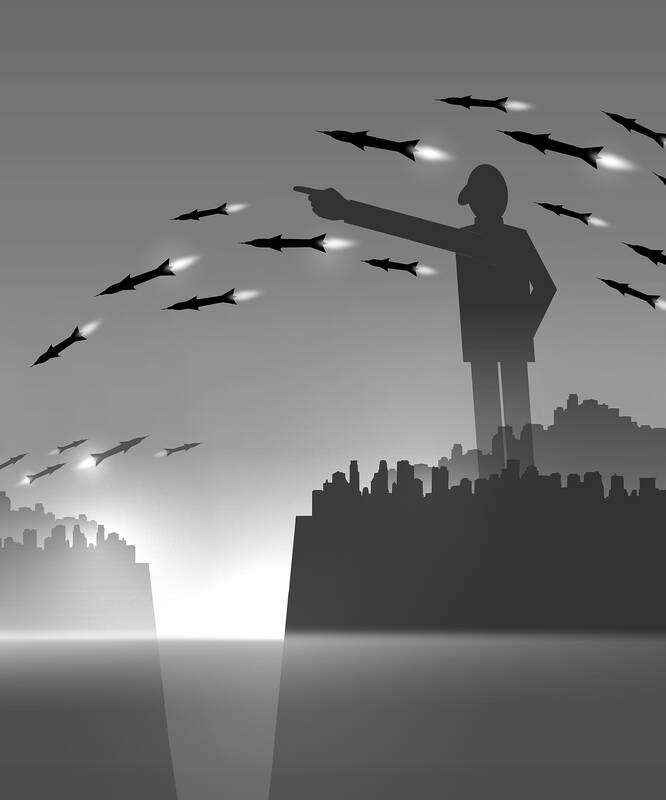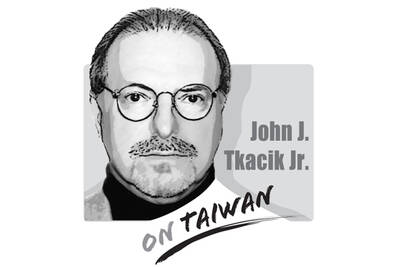Eight decades have passed since the energy contained within an atom was used in warfare. Yet rather than experiencing nuclear Armageddon, the world has achieved a surprising nuclear stability — so far. Equally remarkable, while nuclear technology has spread to many countries, only a small fraction have chosen to use it to develop weapons.
The world has benefited from an effective nonproliferation regime, a set of rules, norms and institutions that have discouraged — albeit haltingly and imperfectly — nuclear proliferation, but can it survive an era of rapid geopolitical shifts?
In the 1960s, then-US president John F. Kennedy predicted that there would be about 25 countries with nuclear weapons by the 1970s. Yet today, there are only nine, because governments took steps to prevent proliferation.

Illustration: Yusha
In 1968, they negotiated the Nuclear Non-Proliferation Treaty (NPT), which recognized that five states already had nuclear weapons, but secured pledges from others not to develop them. For decades, the Vienna-based International Atomic Energy Agency (IAEA) has sent inspectors to countries developing nuclear energy to ensure that it is used only for civilian purposes.
And in the 1970s, then-US president Jimmy Carter’s administration placed a high priority on slowing proliferation, in part through the newly created Nuclear Suppliers Group, whose member states pledged restraint in the export of sensitive enrichment and reprocessing technology.
This non-proliferation regime has become an important part of the world order, but some analysts believe it faces new threats. Even IAEA Director-General Rafael Mariano Grossi worries about its future. The most visible challenge is Iran’s program for enriching uranium to more than 60 percent — far beyond what is needed for use in civilian reactors.
Grossi estimates that Iran could make a bomb in a matter of months, not years; and if it does develop a nuclear weapon, Saudi Arabia says it would follow suit and drop out of the NPT. Israel and the US are threatening to use force to stop Iran, even as the US and Iran engage in new negotiations over limiting Iran’s nuclear program.
Beyond this regional challenge in the Middle East lurks a global threat to the nonproliferation regime. After World War II, Germany and Japan limited their own nuclear plans because of their alliance with the US. The credibility of US nuclear deterrence was sufficient to provide them with security, and the same has been true for dozens of other states, both in NATO and in East Asia.
However, now that the administration of US President Donald Trump is weakening these alliances, it has also weakened the US’ extended deterrence, prompting others to examine whether they should have their own nuclear weapons. They are well aware that Ukraine gave up the Soviet-era nuclear weapons stationed on its soil, only to be invaded by Russia (which had guaranteed Ukraine’s territorial integrity in the 1994 Budapest Memorandum).
Some analysts say we should not worry, because proliferation would have beneficial effects on world politics. Just as nuclear weapons sustained prudence in US-Soviet relations, so might nuclear weapons stabilize regional power balances today.
However, this more-is-better attitude would be tenable only if the political conditions were similar. It presupposes stable command-and-control systems; an absence of serious civil wars or destabilizing motivations (such as irredentist passions); and discipline over the temptation to launch preemptive strikes during the early stages of a conflict, when new nuclear weapons capabilities are soft and vulnerable.
Such assumptions are unrealistic in many parts of the world. Far from enhancing security, the first effects of acquiring a nuclear capability in many circumstances might be to increase one’s vulnerability and insecurity. Moreover, even a local, “tactical” nuclear strike would be a serious breach of an 80-year global taboo.
One also must consider the destabilizing roles that nonstate actors could play. Even if the risk of a terrorist group acquiring a nuclear device is low, the mere possibility creates severe
challenges. The fact that weapons-usable materials can be stolen or sold to rogue states on the black market means that the threat posed by nonstate groups does not depend solely on their technological capabilities.
Nor would today’s superpowers necessarily be immune to the effects. The wide or rapid spread of nuclear capabilities could affect the global strategic balance and the prospects of a peaceful and just world order.
Obviously, political and technical trends would continue to change, but the key question concerns the future of US alliances and extended deterrence. Given that proliferation could be destabilizing, that nuclear weapons do not always enhance the acquiring state’s geopolitical position, and that superpowers cannot fully escape the effects, there should be a strong global interest in maintaining the nonproliferation regime.
Under the current circumstances, some inequality in weaponry is acceptable to most states because the alternative — anarchic equality — is more dangerous. As long as countries can be made better off without a bomb than with one, a policy of slowing the spread of nuclear-weapons technology would rest on a strong foundation.
Realistically, an international regime does not need perfect adherence to have a significant constraining effect, but once erosion of the norms and institutions begins, it might be hard to stop.
Joseph S. Nye, Jr, a former dean of Harvard Kennedy School, is a former US assistant secretary of defense and author of the memoir A Life in the American Century.
Copyright: Project Syndicate

Elbridge Colby, America’s Under Secretary of Defense for Policy, is the most influential voice on defense strategy in the Second Trump Administration. For insight into his thinking, one could do no better than read his thoughts on the defense of Taiwan which he gathered in a book he wrote in 2021. The Strategy of Denial, is his contemplation of China’s rising hegemony in Asia and on how to deter China from invading Taiwan. Allowing China to absorb Taiwan, he wrote, would open the entire Indo-Pacific region to Chinese preeminence and result in a power transition that would place America’s prosperity
When Democratic Progressive Party (DPP) caucus whip Ker Chien-ming (柯建銘) first suggested a mass recall of Chinese Nationalist Party (KMT) legislators, the Taipei Times called the idea “not only absurd, but also deeply undemocratic” (“Lai’s speech and legislative chaos,” Jan. 6, page 8). In a subsequent editorial (“Recall chaos plays into KMT hands,” Jan. 9, page 8), the paper wrote that his suggestion was not a solution, and that if it failed, it would exacerbate the enmity between the parties and lead to a cascade of revenge recalls. The danger came from having the DPP orchestrate a mass recall. As it transpired,
All 24 Chinese Nationalist Party (KMT) lawmakers and suspended Hsinchu Mayor Ann Kao (高虹安), formerly of the Taiwan People’s Party (TPP), survived recall elections against them on Saturday, in a massive loss to the unprecedented mass recall movement, as well as to the ruling Democratic Progressive Party (DPP) that backed it. The outcome has surprised many, as most analysts expected that at least a few legislators would be ousted. Over the past few months, dedicated and passionate civic groups gathered more than 1 million signatures to recall KMT lawmakers, an extraordinary achievement that many believed would be enough to remove at
A few weeks ago in Kaohsiung, tech mogul turned political pundit Robert Tsao (曹興誠) joined Western Washington University professor Chen Shih-fen (陳時奮) for a public forum in support of Taiwan’s recall campaign. Kaohsiung, already the most Taiwanese independence-minded city in Taiwan, was not in need of a recall. So Chen took a different approach: He made the case that unification with China would be too expensive to work. The argument was unusual. Most of the time, we hear that Taiwan should remain free out of respect for democracy and self-determination, but cost? That is not part of the usual script, and